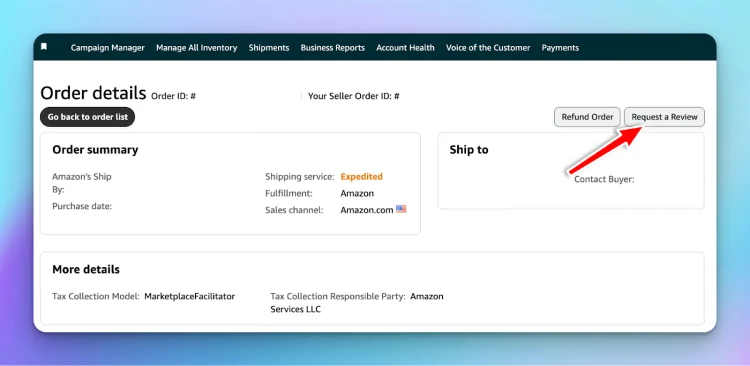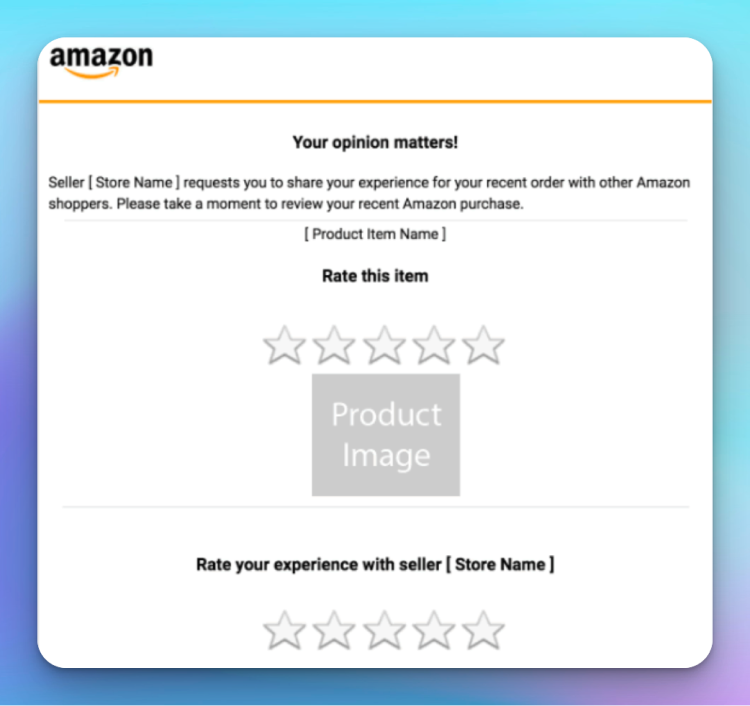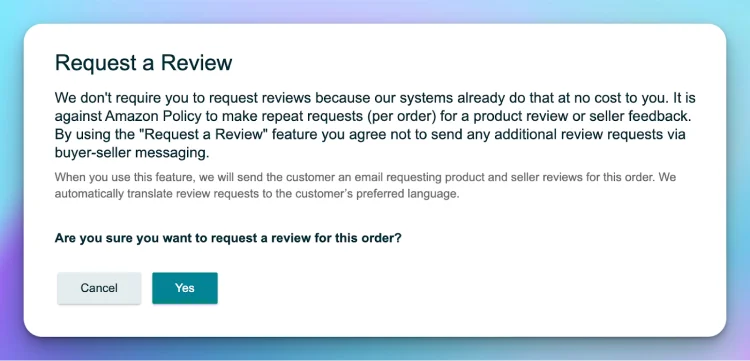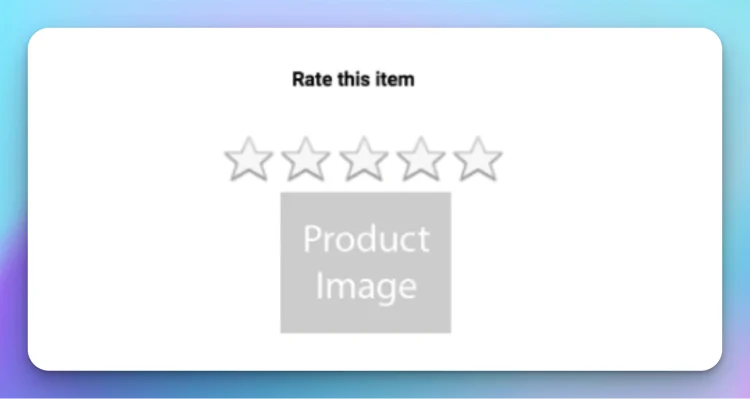If you’ve been selling on Amazon for any length of time, you’ll know that reviews are absolutely essential to your success.
Their most fundamental benefit? Turning browsers into buyers.
The compounding benefit? Increased conversion rates help your listings rank higher in search results, which helps increase conversions. And the cycle continues.
So, how do you get more reviews?
The Amazon “Request a Review” button is a great start. In this guide we’ll walk you through how to get the best results from this powerful tool.
What Is the Amazon “Request a Review” Button?
The “Request a Review” button is a feature inside your Amazon Seller Central account that, when clicked, immediately sends an email to the buyer asking for a review.
With a growing number of Amazon customers opting out of the traditional buyer-seller messaging system, the request button presents a great opportunity for getting a consistent flow of reviews for your products.
And using the button is simple:
Navigate to the “Manage Orders” section of your Amazon Seller Central account.
Click through to an individual order details page by selecting an order number. Simply click the “Request a Review” button in the top right corner of the individual review, and confirm you want the system to send a review request. Amazon will send a pre-formatted email in the customer’s preferred language.

If you’ve got a ton of sales coming in, carrying out this process can become rather time-consuming.
But like many aspects of your Amazon business, you can streamline and automate review requests by using a tool such as Carbon6’s SellerTools. With an automation tool like this, you never have to manually request a review again.
What Does the “Request a Review” Email Look Like?
Amazon’s templated email is designed to greet the customer, thank them for their order, and ask them to rate the product using a five-star system.
Customers can then simply tap a star rating on the email to rate the product. Then, they have the option to leave a written review alongside their star rating.

Ever since Amazon made written reviews optional, customers tend to give star ratings without leaving a comment about the product.
Generally, you’ll see around a 10-20% comment-to-rating ratio.
The good news?
The convenience of leaving a rating makes it easier to generate a higher quantity of ratings — leading to more optimized Amazon listings — even if the quality of written reviews isn’t always as good.
Can Sellers Customize Amazon’s Email Template?
Since Amazon creates and manages the email template, sellers aren’t given access to the content of the email, nor are they given the option to customize any element of it.
If you’re looking to send a custom branded message, consider sending personalized requests through the buyer-seller messaging tool.
Can Sellers Send a Request via Buyer-Seller Messaging, Too?
Given that the ”Request a Review” button initiates an email, sending the customer an additional request for a review via the buyer-seller messaging system would go against Amazon’s guidelines.
The Amazon terms of service state that “Permitted Messages do not include any of the following message types,” such as a repeat request (per order) for a product review or seller feedback.
Amazon gives another warning when sellers manually request a review:

The takeaway?
Doubling up with additional review requests would leave you in danger of breaking Amazon’s rules.
So what are the benefits and limitations of either review request method? And which one is right for you? Let’s explore.
Request a Review vs. Buyer-Seller Messaging: Pros and Cons
Before determining which popular review request method should be part of your long-term strategy, consider the strengths and weaknesses of both.
“Request a Review” Button: The Pros
1. Higher Deliverability
A growing number of customers have opted out of buyer-seller communications since Amazon enabled the feature.
This means there’s a reduced chance your customer will see your review request if you send it through the buyer-seller messaging system.
The “Request a Review” button circumvents this issue, as Amazon manages the whole process and ensures the message is delivered — which can lead to higher review rates.
2. Higher Review Rates
In addition to higher deliverability, the Amazon templated request also features an interactive star graphic that encourages the user to click.

The visual engagement — combined with the request landing in more inboxes — leads to a compound effect of higher overall review quantities.
3. Automatic Translation
Each Amazon customer has the option to set their preferred language within their account for any incoming communications.
Whenever you use the “Request a Review” button, Amazon automatically translates the request into the customer’s chosen language, giving your overall engagement a boost.
“Request a Review” Button: The Cons
1. Lower-Quality Reviews
With this method, customers can quickly and easily click a star rating without leaving a comment.
As such, more and more customers aren’t leaving comments alongside their star ratings.
Without written reviews, other buyers struggle to understand the product’s strengths and weaknesses, which can hamper the conversion rate boost seen when customers leave detailed positive reviews.
Brand owners also have difficulty understanding the rationale behind negative reviews, making it hard to adjust accordingly.
2. Lack of Flexibility
Since Amazon provides the rigid template, sellers have no flexibility or ability to customize the email request.
This makes it impossible to maintain a brand voice or to test strategies that may increase engagement and overall review rates.
3. Inability to Track Open or Click Rates
Unlike email marketing platforms, Amazon doesn’t provide any metrics to show you how successful your review request campaign has been.
Without these insights, it’s hard how effective your review generation efforts are.
Buyer-Seller Messaging Requests: The Pros
1. Fully Customizable
When sending a request for a review via buyer-seller messaging, you have complete control over the message.
You can create an on-brand message that’s aligned to any other customer communications you may be sending.
2. Personalization
With the buyer-seller messaging system, you’re given the opportunity to send each customer a personalized message based on their order or purchase.
You can include order-specific aspects like product images to help encourage further engagement.
Buyer-Seller Messaging Requests: The Cons
1. Increasing Opt-Out Rate
Customers have been increasingly opting-out of buyer-seller communications over time.
In the early days, the opt-out rate was around 2%. Now, we’re seeing rates as high as 30%, which can lead to a much lower deliverability rate.
2. Lower Review Rates
Even if your customer message is successfully delivered, there’s no guarantee the customer will leave a review.
The Amazon “Request a Review” button has a higher overall review rate, which can be attributed to the more engaging template and the fact that there’s no opt-out option. Also, having templated emails come from Amazon is an added bonus, as it helps increase trust and confidence.
3. Risk of Breaking Amazon’s Rules
When first learning how to sell on Amazon, many sellers underestimate the restrictions Amazon places on communication with buyers.
Primarily, you can’t include links in your message, and you can’t incentivize customers to leave reviews.
Failure to comply with Amazon’s many messaging rules can leave you at risk of having your account suspended.
Given the Amazon “Request a Review” button template originates from Amazon, you can rest assured that it will be compliant at all times.
Which Review Request Method Is Best?
So, which method should you use?
The answer, as is often the case, is: It depends.
If you’re looking for a quick and easy way to increase your review numbers, then the Amazon “Request a Review” button is a good option.
If you’re looking for more flexibility and brand-aligned communications, however, then the buyer-seller messaging system is the better option.
At the end of the day, it’s important to experiment and see what works best for your business. Both methods have their advantages and disadvantages, so it’s important to test and see which one leads to the best results for your particular products and customers.




